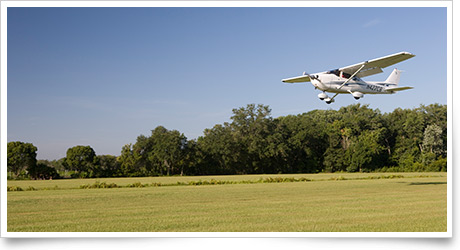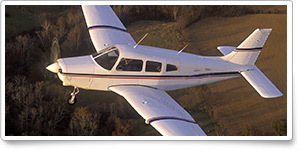| ||||||
| The other ‘frequencies’ |
| |||||
Training TipsThe other ‘frequencies’ Be sure to explore this corner of the aviation universe. Perhaps a session practicing landings and takeoffs from short or unpaved strips, or a cross-country flight will take you there. Whether you are a visitor to this realm or a based aviator, knowing the rules and etiquette promotes safety and rounds out your knowledge of aviation’s diverse community. Not every aircraft you spot in the pattern here is capable of making radio position reports. Knowing that no-radio aircraft are present should remind you that “seeing” is the true key to see-and-avoid flying. Checking your sectional chart, or an airport listing, for information about the no-tower, no-unicom airport that is today’s cross-country destination, you note that it is assigned the common traffic advisory frequency 122.9 MHz, as prescribed in Section 4-1-11 of the Aeronautical Information Manual. Make all the usual position reports. It would be wrong to assume, as some pilots do, that such a place cannot become extremely active (especially on a beautiful day in early spring). A related safety tip: Unfortunately, there are still some pilots out there who erroneously make their traffic calls at so-called unattended airports on several of the most familiar of the seven frequencies assigned to airports without an operating control tower (typically, 122.8 MHz)—so it might be a good idea to monitor (but not transmit on) that channel too. Another precaution: Be aware that pilots of local private fixed-wing aircraft that are not coming or going from the airport may be transmitting back and forth on the prescribed air-to-air frequency: 122.75 MHz. (There is also an air-to-air frequency for general aviation helicopters. Would you be able to provide it, if your communications knowledge were probed by a designated examiner on a checkride?) It’s tempting to think of remote or unattended airports as small or unimproved—but that’s not always the case. The unattended airport in Espanola, N.M., has a paved 5,007-foot-long runway, but at a field elevation of 5,790 feet msl, that may not seem especially lengthy when you calculate aircraft performance to be expected under high-density-altitude conditions. Flight Training NewsFAA eases special issuance burdenStarting July 20, pilots who have a medical certificate with a special issuance authorization will no longer need to carry the separate authorization letter with them in the aircraft. It’s a small change in the regulations, but it’s designed to ease the document-carrying requirement for the 28,000 pilots who already endure the extra burden and expense of obtaining a special issuance. Read more >> New Real Pilot Story: Trapped on topWe often think of emergencies as one-at-a-time events, but as pilot Jim Lawson discovered, bad things sometimes come in pairs. Imagine yourself as a noncurrent instrument pilot dealing with an unexpected descent through clouds—then add fuel-exhaustion-induced engine failure. How would you cope? Who would you look to for help? Listen in as a team of ATC specialists mounts an effort to get the overwhelmed pilot on the ground safely in the latest installment of the Air Safety Institute’s Real Pilot Stories series, produced with the generous support of the National Air Traffic Controllers Association and underwritten by the AOPA Insurance Agency. FAA: Digital chart fee plan still in developmentThe FAA says it won’t begin imposing fees on third-party digital chart providers next week, as had originally been contemplated. The agency said March 23 it is still verifying costs and pricing, and there is no definite timetable to implement a new fee structure. Read more >> Ariz. flight school sponsors global flightGuidance Aviation of Prescott, Ariz., has donated a Cirrus SR20 that will be flown around the world in 2013 to promote education, aviation, and aerospace. Judy Rice will fly the aircraft for the ThinkGlobalFlight.org mission. She plans to interact with children ages 4 through 16 via “student command centers.” Participants will be able to track her progress via the Internet, streaming audio, video, podcasts, and other Web-based media. The Cirrus is on display this week at the Sun ’n Fun Fly-In at Lakeland, Fla. Read more >> Nominations open for A. Scott Crossfield AwardDo you know a dedicated teacher whose passion and commitment is noteworthy? Nominations are now open for the A. Scott Crossfield Aerospace Education Teacher of the Year, sponsored by the National Aviation Hall of Fame. The 2012 recipient will receive a $1,500 cash stipend, and will be a guest at the NAHF’s fiftieth annual enshrinement ceremony on Oct. 6. See the website for details. Training ResourcesLearning the intricacies of today's airspace is a big task and a necessary one for every pilot. Let the Air Safety Institute help with the Know Before You Go: Navigating Today’s Airspace online course. In one place, you’ll find everything you need to know about the various types of airspace, communication requirements, weather minimums, and more. And for those times when you don’t have access to a computer, download the Airspace Flashcards as a quiz tool for yourself or fellow students. Don’t take to the skies without knowing what you’re launching into.
Did you know that student pilots who join AOPA are three times more likely to complete their flight training? Membership includes unlimited access to aviation information by phone (800/USA-AOPA, weekdays from 8:30 a.m. to 6 p.m. Eastern time) or from Flight Training Online or AOPA Online. If you're not already a member, join today and get the pilot’s edge. Login information is available online. Making decisions Career PilotAirline trade organization seeks tax, regulatory reformAirlines for America (A4A), an industry trade organization for U.S. airlines, on March 19 asked the U.S. government to reform federal taxes and regulations to enable U.S. carriers to compete globally on a level playing field, and to help grow the country’s economy. A4A President and CEO Nicholas E. Calio detailed the excessive tax and regulatory burden faced by the airline industry and its passengers, saying it is one of the most highly regulated businesses in America—even though Congress deregulated the industry nearly 35 years ago. US Airways employees to share $12 million in profitsUS Airways announced March 14 that, for the second year in a row, employees will receive profit-sharing checks recognizing their contribution to the company's full-year profit. US Airways reported a $111 million profit for 2011, and will pay out more than $12 million to eligible employees. Airline employees also earned more than $13 million in operational incentive bonuses over the past year, bringing the total in recognition payouts for US Airways employees to more than $25 million for 2011. Plane SpotterCherokees and Warriors: Two of a kind Training ProductsNflightcam cockpit video cameras from Sporty’sYou can’t be a fly on the wall of your own airplane, but you can view in-cockpit video footage and listen to yourself on the radio after a flight, thanks to the wave of small HD video cameras on the market. Sporty’s offers the Nflightcam Sport and Plus models. Both feature one-button operation and record full 1080p HD video. Both include software that let the user edit and share videos using Mac or Windows. The Sport sells for $299. The Plus features a lens that eliminates propeller blur and a built-in GPS that logs your position as it records, among other features. The Plus sells for $499. Order online or call 800/776-7897.
Note: Products listed have not been evaluated by ePilot editors unless otherwise noted. AOPA assumes no responsibility for products or services listed or for claims or actions by manufacturers or vendors. Member BenefitsBreathe in, breathe outYou may think you function perfectly well at 10,000 feet msl, but chances are your blood oxygen levels say otherwise. Dr. Jonathan Sackier tells you why this matters, and how to remedy it. Read more >> Insider tips for completing aircraft registrationsWhen it comes to filling out an aircraft registration form that goes to the FAA, there's one surprising rule: "Neatness counts." Learn more ways to get your application processed as quickly as possible from AIC Title. Read more >> BlogsThe best instrument there isIn this week’s Flight Training blog, Chip Wright talks about the most important instrument in the aircraft (it’s not the GPS!) and also how different airlines do the same things … differently. Also, Technical Editor Jill W. Tallman wishes the Piper Cub a happy seventy-fifth birthday. Let’s keep making GA memoriesTodd McClamroch reflects on the impending closing of Blue Ash Airport, where he soloed and earned his private pilot certificate, in the latest installment of the Let’s Go Flying blog. AOPA Career OpportunitiesEver dream of turning your passion for aviation into a career? We’re looking for a vice president of strategy and philanthropic operations, director of accounting, program manager—products, project manager of online products, manager of regulatory affairs, director of new market development, associate project manager, aviation education program developer, and associate editor–Web/ ePilot. To learn more about other AOPA career opportunities, visit AOPA Online. Community
AVIATION EVENTS & WEATHER
| ||||||||||||||||||||||||||||||||||||




 Away from the hustle and bustle of busy airports and airspace designated by one of the second through fourth letters of the alphabet, general aviation leads a more secluded—but equally active—life.
Away from the hustle and bustle of busy airports and airspace designated by one of the second through fourth letters of the alphabet, general aviation leads a more secluded—but equally active—life.





